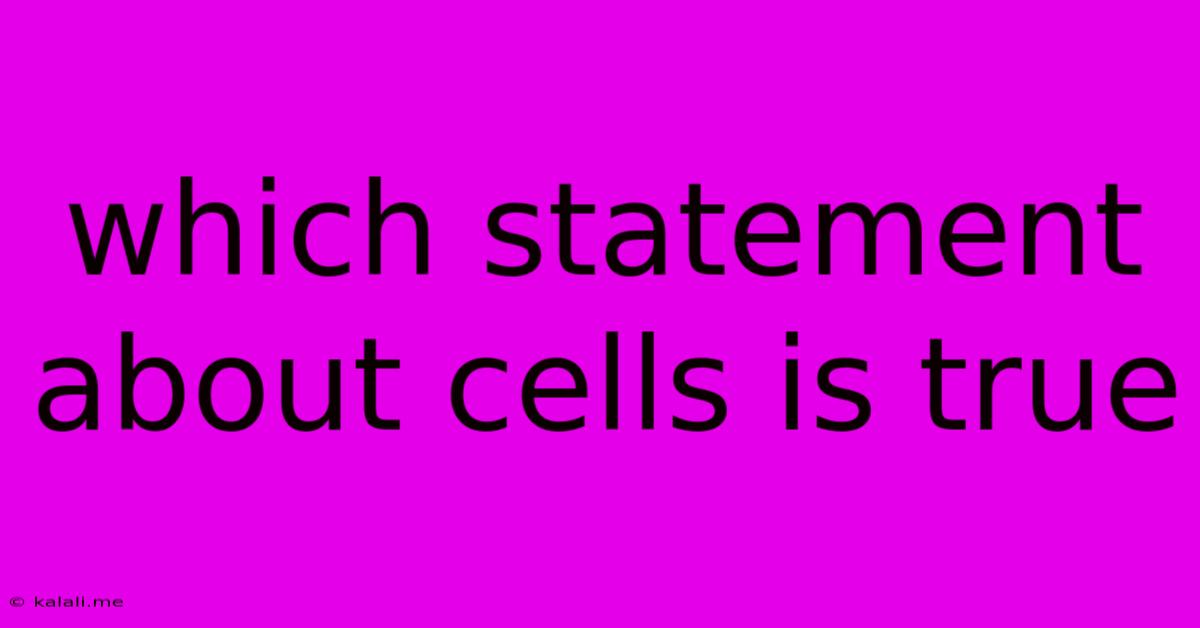Which Statement About Cells Is True
Kalali
Jun 14, 2025 · 3 min read

Table of Contents
Which Statement About Cells Is True? Decoding the Fundamentals of Cell Biology
This article will explore several common statements about cells and determine which one is true. Understanding cells is fundamental to biology, so let's dive into the core principles and clarify some common misconceptions. The meta description is: Learn which statement about cells is true! We clarify common misconceptions about cell biology, exploring fundamental principles and debunking myths.
Understanding the Basic Cell Principles
Before we analyze the statements, let's refresh our understanding of cells. Cells are the basic structural and functional units of all living organisms. This means everything from microscopic bacteria to the largest whales is made up of these tiny building blocks. There are two main types of cells:
- Prokaryotic cells: These are simpler cells lacking a nucleus and other membrane-bound organelles. Bacteria are examples of organisms composed of prokaryotic cells.
- Eukaryotic cells: These are more complex cells possessing a nucleus and various membrane-bound organelles like mitochondria, endoplasmic reticulum, and Golgi apparatus. Plants, animals, fungi, and protists are all made up of eukaryotic cells.
Analyzing Common Statements About Cells
Now, let's look at some common statements regarding cells and determine their accuracy. Many statements related to cell biology are true in some contexts, but not all. Precision is crucial.
Statement 1: All cells contain a nucleus.
This statement is false. As mentioned earlier, prokaryotic cells lack a nucleus. Their genetic material is located in a region called the nucleoid, which is not membrane-bound.
Statement 2: Cells are only found in multicellular organisms.
This statement is also false. Unicellular organisms, like bacteria and many protists, are made up of a single cell. Multicellular organisms, on the other hand, are composed of trillions of cells working together.
Statement 3: All cells have a cell membrane.
This statement is true. The cell membrane, or plasma membrane, is a crucial component of all cells. It acts as a barrier, regulating the passage of substances into and out of the cell, maintaining its internal environment. This membrane is selectively permeable, meaning it controls what enters and exits.
Statement 4: Cells are always microscopic.
While many cells are microscopic, this statement is false. Some cells, like certain nerve cells or muscle fibers, can be quite large and visible to the naked eye. Size is highly variable depending on the cell type and its function.
Statement 5: Cells contain DNA.
This statement is true. DNA, or deoxyribonucleic acid, carries the genetic information that directs the cell's activities and determines its characteristics. The location of this DNA differs between prokaryotic and eukaryotic cells (nucleoid vs. nucleus), but it's present in both.
Conclusion: The Truth About Cells
The statement that is definitively true about all cells is that all cells have a cell membrane. This fundamental structure is essential for the existence and function of any cell, regardless of its complexity or type. Understanding this and other core principles of cell biology is vital for grasping the complexities of life itself. Further research into specific cell types and their functions will reveal even more fascinating details about the microscopic world within us.
Latest Posts
Latest Posts
-
The Asteroid Belt Lies Between The Orbits Of
Jun 15, 2025
-
Milk Of Magnesia Base Or Acid
Jun 15, 2025
-
Is H2po4 An Acid Or Base
Jun 15, 2025
-
The End Product Of Protein Digestion Is
Jun 15, 2025
-
The Speed Of A Printer Is Measured In
Jun 15, 2025
Related Post
Thank you for visiting our website which covers about Which Statement About Cells Is True . We hope the information provided has been useful to you. Feel free to contact us if you have any questions or need further assistance. See you next time and don't miss to bookmark.